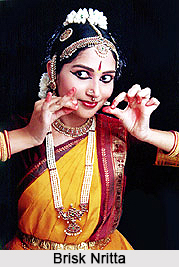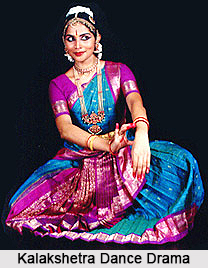
Brisk Nritta and uncommonly bright abhinaya, over and above a graceful lithe figure distinguishes Ganga Thampi`s Bharathanatyam recital. Ganga Thampi with her large expressive eyes further carried "Abhinaya" to the next level of maturity. Ganga Thampi was born and brought up in an atmosphere that was filled with classical dance and music. She started learning Kathakali from the tender age of 10. Her father Shri Madavoor Vasudevan Nair, who is considered as the senior most Kathakali Maestro was her first guru. Shri Madavoor Vasudevan Nair won the Kendra Sangeetha Natak Academy Award for the year 1977. She was admitted to the Kalakshetra Foundation, Chennai for her diploma course in Bharathanatyam after finishing her pre-university course in Kerala.
Ganga Thampi, during her six-year time at Kalakshetra, completed her BA and MA in English Literature through a correspondence course from Madras University. One golden opportunity came on her way at Kalakshetra, as she got a chance to be under the tutelage of the famous guru Sharada Hoffman. She was under his strict discipline for 4 years and under the guidance of Kalaimamani Krishnaveni Lakshmanan for 2 years. She continued in Kalakshetra as a guest artist after finishing her post graduation diploma course.  As a lecturer in Bharathanatyam, she joined the Kalakshetra Foundation in the year 1996.
As a lecturer in Bharathanatyam, she joined the Kalakshetra Foundation in the year 1996.
Ganga Thampi, as a dancer, has performed instrumental roles in many of the Kalakshetra Dance Dramas like Sita in "Ramayanam", Saraswathi Bhai in "Purandara Dasa", Parvathi in "Siva Geethi Mala", Madanavalli in "Krishnamari Kuravanchi", Radha in "Geetha Govindam" etc. With the Kalakshetra troupe, she has comprehensively toured the west and many parts of India. In the year 1996, she has delineated Indian Art and Culture by performing in South Africa in Bharathotsav. To name a few Music Academy, Natya Arangam and Sopanam the Natyanjali Trust, Nrityanjali Trust are some of them. As a judge Ganga has participated in the Kerala State Youth Festival for the year of 1998. This festival is considered as Asia`s biggest Art Festival.
In the year 1996, the MGR Award was conferred to Ganga by the Madras Music Academy. These days, for "Kaladarpanam" Magazine, Ganga is working as the Chennai correspondent. The Sree Sankara University of Sanskrit (Kalady, Kerala), she has been nominated as Member of Board of Studies in Dance. Ganga has masterminded a Dance poem "Chintavishtayaya Sita". It was based on a poem written by the great Malayalam poet Shri Kumaran Asan. Her creativity, skillfulness and astonishing perseverance all clubbed together into her creations in the form of dance.



















